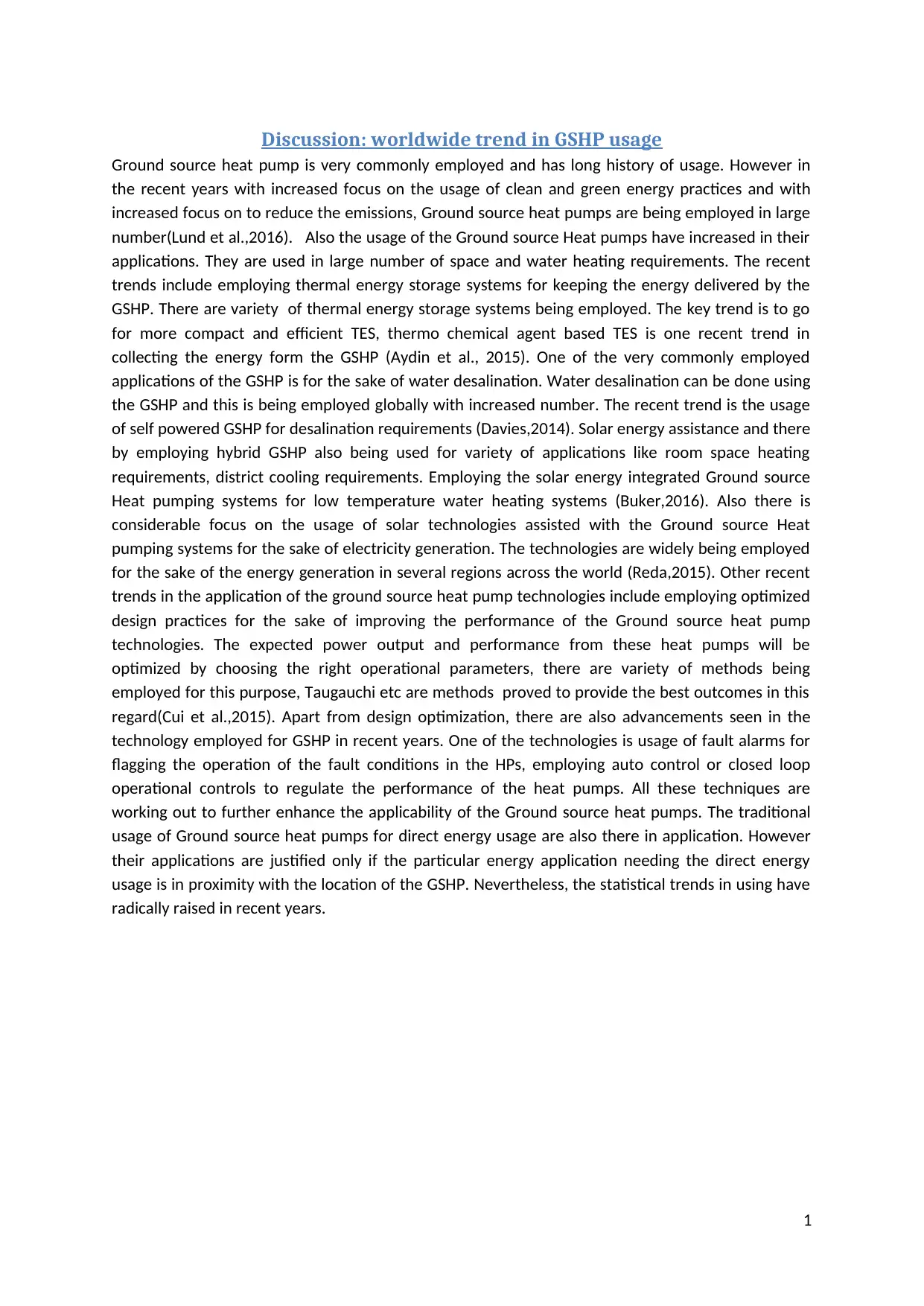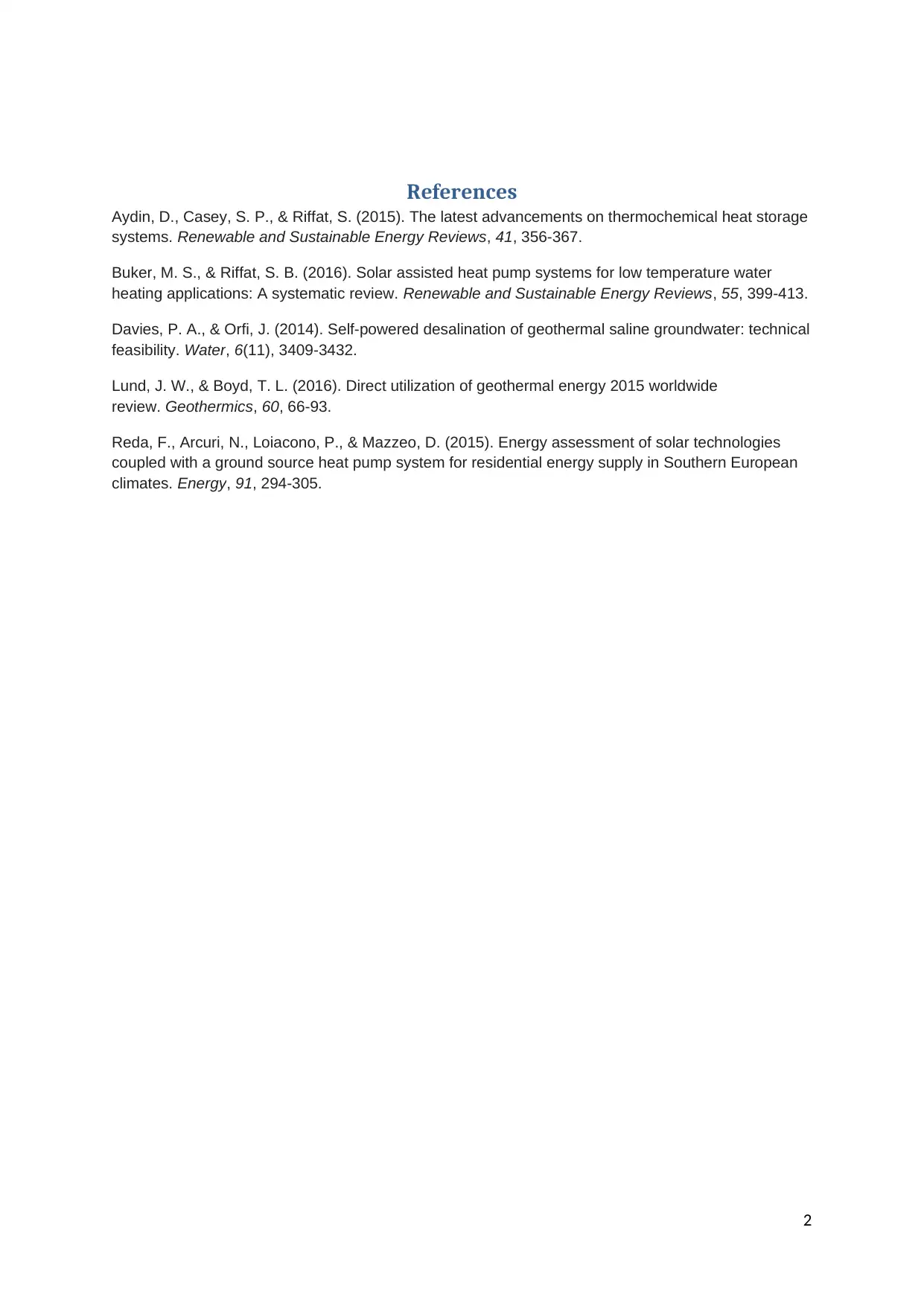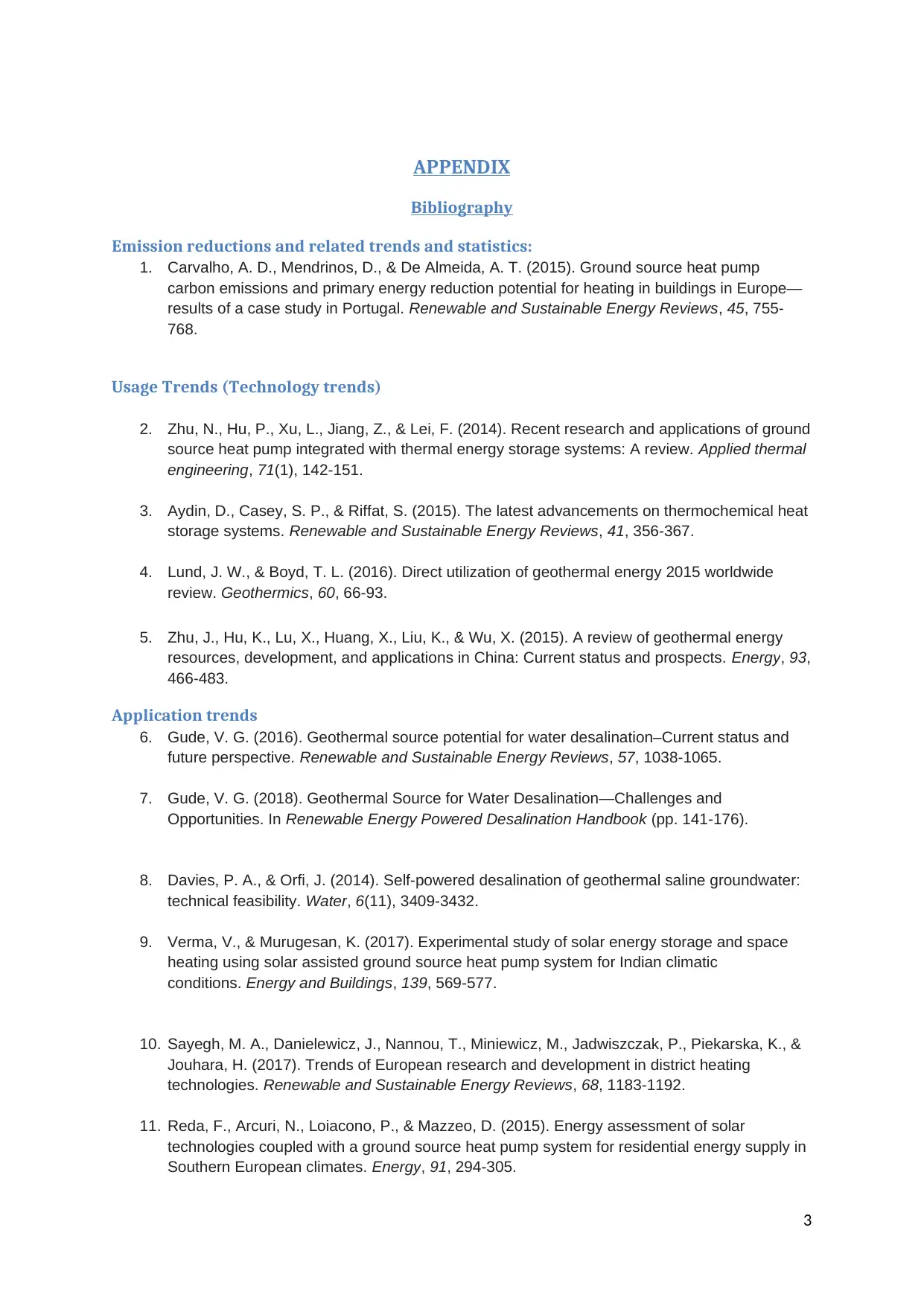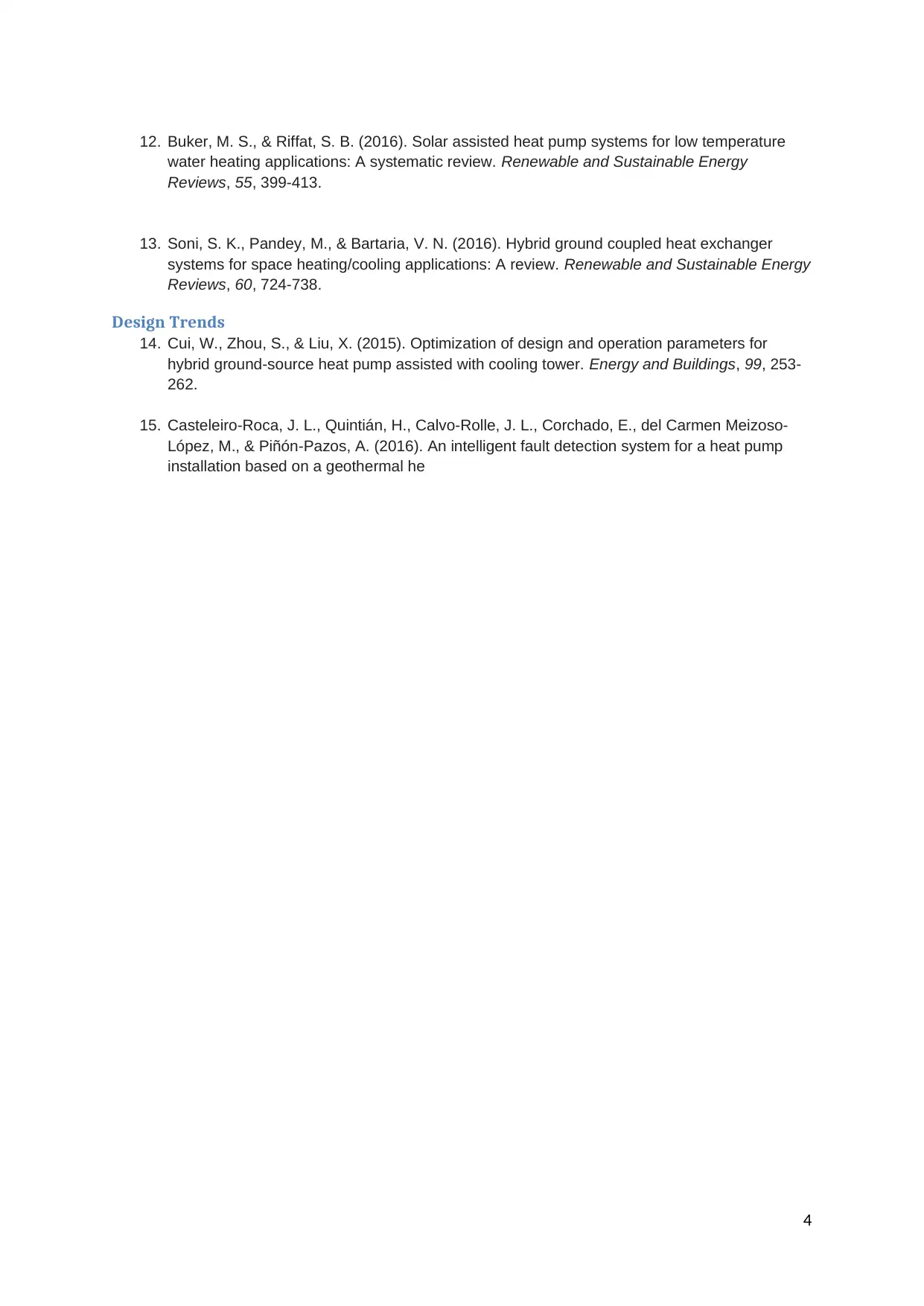Exploring Worldwide Trends in Ground Source Heat Pump Technology
VerifiedAdded on 2023/06/10
|4
|1399
|335
Discussion Board Post
AI Summary
This discussion post examines the increasing global trend in Ground Source Heat Pump (GSHP) usage, driven by a focus on clean energy and emission reduction. It highlights the expanded applications of GSHPs in space and water heating, including the integration of thermal energy storage systems like compact thermo-chemical TES. The post also discusses the use of GSHPs in water desalination, particularly self-powered systems, and the rise of solar-assisted hybrid GSHP systems for various applications such as room heating, district cooling, and low-temperature water heating. Furthermore, it explores design optimization practices, advancements in fault alarm technologies, and auto-control systems aimed at enhancing GSHP performance. While traditional direct energy usage of GSHPs persists, their application is most effective when energy needs are in close proximity to the GSHP location. The analysis is supported by a range of references providing detailed insights into these trends and technologies. Desklib provides similar solved assignments and past papers for students.

Discussion: worldwide trend in GSHP usage
Ground source heat pump is very commonly employed and has long history of usage. However in
the recent years with increased focus on the usage of clean and green energy practices and with
increased focus on to reduce the emissions, Ground source heat pumps are being employed in large
number(Lund et al.,2016). Also the usage of the Ground source Heat pumps have increased in their
applications. They are used in large number of space and water heating requirements. The recent
trends include employing thermal energy storage systems for keeping the energy delivered by the
GSHP. There are variety of thermal energy storage systems being employed. The key trend is to go
for more compact and efficient TES, thermo chemical agent based TES is one recent trend in
collecting the energy form the GSHP (Aydin et al., 2015). One of the very commonly employed
applications of the GSHP is for the sake of water desalination. Water desalination can be done using
the GSHP and this is being employed globally with increased number. The recent trend is the usage
of self powered GSHP for desalination requirements (Davies,2014). Solar energy assistance and there
by employing hybrid GSHP also being used for variety of applications like room space heating
requirements, district cooling requirements. Employing the solar energy integrated Ground source
Heat pumping systems for low temperature water heating systems (Buker,2016). Also there is
considerable focus on the usage of solar technologies assisted with the Ground source Heat
pumping systems for the sake of electricity generation. The technologies are widely being employed
for the sake of the energy generation in several regions across the world (Reda,2015). Other recent
trends in the application of the ground source heat pump technologies include employing optimized
design practices for the sake of improving the performance of the Ground source heat pump
technologies. The expected power output and performance from these heat pumps will be
optimized by choosing the right operational parameters, there are variety of methods being
employed for this purpose, Taugauchi etc are methods proved to provide the best outcomes in this
regard(Cui et al.,2015). Apart from design optimization, there are also advancements seen in the
technology employed for GSHP in recent years. One of the technologies is usage of fault alarms for
flagging the operation of the fault conditions in the HPs, employing auto control or closed loop
operational controls to regulate the performance of the heat pumps. All these techniques are
working out to further enhance the applicability of the Ground source heat pumps. The traditional
usage of Ground source heat pumps for direct energy usage are also there in application. However
their applications are justified only if the particular energy application needing the direct energy
usage is in proximity with the location of the GSHP. Nevertheless, the statistical trends in using have
radically raised in recent years.
1
Ground source heat pump is very commonly employed and has long history of usage. However in
the recent years with increased focus on the usage of clean and green energy practices and with
increased focus on to reduce the emissions, Ground source heat pumps are being employed in large
number(Lund et al.,2016). Also the usage of the Ground source Heat pumps have increased in their
applications. They are used in large number of space and water heating requirements. The recent
trends include employing thermal energy storage systems for keeping the energy delivered by the
GSHP. There are variety of thermal energy storage systems being employed. The key trend is to go
for more compact and efficient TES, thermo chemical agent based TES is one recent trend in
collecting the energy form the GSHP (Aydin et al., 2015). One of the very commonly employed
applications of the GSHP is for the sake of water desalination. Water desalination can be done using
the GSHP and this is being employed globally with increased number. The recent trend is the usage
of self powered GSHP for desalination requirements (Davies,2014). Solar energy assistance and there
by employing hybrid GSHP also being used for variety of applications like room space heating
requirements, district cooling requirements. Employing the solar energy integrated Ground source
Heat pumping systems for low temperature water heating systems (Buker,2016). Also there is
considerable focus on the usage of solar technologies assisted with the Ground source Heat
pumping systems for the sake of electricity generation. The technologies are widely being employed
for the sake of the energy generation in several regions across the world (Reda,2015). Other recent
trends in the application of the ground source heat pump technologies include employing optimized
design practices for the sake of improving the performance of the Ground source heat pump
technologies. The expected power output and performance from these heat pumps will be
optimized by choosing the right operational parameters, there are variety of methods being
employed for this purpose, Taugauchi etc are methods proved to provide the best outcomes in this
regard(Cui et al.,2015). Apart from design optimization, there are also advancements seen in the
technology employed for GSHP in recent years. One of the technologies is usage of fault alarms for
flagging the operation of the fault conditions in the HPs, employing auto control or closed loop
operational controls to regulate the performance of the heat pumps. All these techniques are
working out to further enhance the applicability of the Ground source heat pumps. The traditional
usage of Ground source heat pumps for direct energy usage are also there in application. However
their applications are justified only if the particular energy application needing the direct energy
usage is in proximity with the location of the GSHP. Nevertheless, the statistical trends in using have
radically raised in recent years.
1
Paraphrase This Document
Need a fresh take? Get an instant paraphrase of this document with our AI Paraphraser

References
Aydin, D., Casey, S. P., & Riffat, S. (2015). The latest advancements on thermochemical heat storage
systems. Renewable and Sustainable Energy Reviews, 41, 356-367.
Buker, M. S., & Riffat, S. B. (2016). Solar assisted heat pump systems for low temperature water
heating applications: A systematic review. Renewable and Sustainable Energy Reviews, 55, 399-413.
Davies, P. A., & Orfi, J. (2014). Self-powered desalination of geothermal saline groundwater: technical
feasibility. Water, 6(11), 3409-3432.
Lund, J. W., & Boyd, T. L. (2016). Direct utilization of geothermal energy 2015 worldwide
review. Geothermics, 60, 66-93.
Reda, F., Arcuri, N., Loiacono, P., & Mazzeo, D. (2015). Energy assessment of solar technologies
coupled with a ground source heat pump system for residential energy supply in Southern European
climates. Energy, 91, 294-305.
2
Aydin, D., Casey, S. P., & Riffat, S. (2015). The latest advancements on thermochemical heat storage
systems. Renewable and Sustainable Energy Reviews, 41, 356-367.
Buker, M. S., & Riffat, S. B. (2016). Solar assisted heat pump systems for low temperature water
heating applications: A systematic review. Renewable and Sustainable Energy Reviews, 55, 399-413.
Davies, P. A., & Orfi, J. (2014). Self-powered desalination of geothermal saline groundwater: technical
feasibility. Water, 6(11), 3409-3432.
Lund, J. W., & Boyd, T. L. (2016). Direct utilization of geothermal energy 2015 worldwide
review. Geothermics, 60, 66-93.
Reda, F., Arcuri, N., Loiacono, P., & Mazzeo, D. (2015). Energy assessment of solar technologies
coupled with a ground source heat pump system for residential energy supply in Southern European
climates. Energy, 91, 294-305.
2

APPENDIX
Bibliography
Emission reductions and related trends and statistics:
1. Carvalho, A. D., Mendrinos, D., & De Almeida, A. T. (2015). Ground source heat pump
carbon emissions and primary energy reduction potential for heating in buildings in Europe—
results of a case study in Portugal. Renewable and Sustainable Energy Reviews, 45, 755-
768.
Usage Trends (Technology trends)
2. Zhu, N., Hu, P., Xu, L., Jiang, Z., & Lei, F. (2014). Recent research and applications of ground
source heat pump integrated with thermal energy storage systems: A review. Applied thermal
engineering, 71(1), 142-151.
3. Aydin, D., Casey, S. P., & Riffat, S. (2015). The latest advancements on thermochemical heat
storage systems. Renewable and Sustainable Energy Reviews, 41, 356-367.
4. Lund, J. W., & Boyd, T. L. (2016). Direct utilization of geothermal energy 2015 worldwide
review. Geothermics, 60, 66-93.
5. Zhu, J., Hu, K., Lu, X., Huang, X., Liu, K., & Wu, X. (2015). A review of geothermal energy
resources, development, and applications in China: Current status and prospects. Energy, 93,
466-483.
Application trends
6. Gude, V. G. (2016). Geothermal source potential for water desalination–Current status and
future perspective. Renewable and Sustainable Energy Reviews, 57, 1038-1065.
7. Gude, V. G. (2018). Geothermal Source for Water Desalination—Challenges and
Opportunities. In Renewable Energy Powered Desalination Handbook (pp. 141-176).
8. Davies, P. A., & Orfi, J. (2014). Self-powered desalination of geothermal saline groundwater:
technical feasibility. Water, 6(11), 3409-3432.
9. Verma, V., & Murugesan, K. (2017). Experimental study of solar energy storage and space
heating using solar assisted ground source heat pump system for Indian climatic
conditions. Energy and Buildings, 139, 569-577.
10. Sayegh, M. A., Danielewicz, J., Nannou, T., Miniewicz, M., Jadwiszczak, P., Piekarska, K., &
Jouhara, H. (2017). Trends of European research and development in district heating
technologies. Renewable and Sustainable Energy Reviews, 68, 1183-1192.
11. Reda, F., Arcuri, N., Loiacono, P., & Mazzeo, D. (2015). Energy assessment of solar
technologies coupled with a ground source heat pump system for residential energy supply in
Southern European climates. Energy, 91, 294-305.
3
Bibliography
Emission reductions and related trends and statistics:
1. Carvalho, A. D., Mendrinos, D., & De Almeida, A. T. (2015). Ground source heat pump
carbon emissions and primary energy reduction potential for heating in buildings in Europe—
results of a case study in Portugal. Renewable and Sustainable Energy Reviews, 45, 755-
768.
Usage Trends (Technology trends)
2. Zhu, N., Hu, P., Xu, L., Jiang, Z., & Lei, F. (2014). Recent research and applications of ground
source heat pump integrated with thermal energy storage systems: A review. Applied thermal
engineering, 71(1), 142-151.
3. Aydin, D., Casey, S. P., & Riffat, S. (2015). The latest advancements on thermochemical heat
storage systems. Renewable and Sustainable Energy Reviews, 41, 356-367.
4. Lund, J. W., & Boyd, T. L. (2016). Direct utilization of geothermal energy 2015 worldwide
review. Geothermics, 60, 66-93.
5. Zhu, J., Hu, K., Lu, X., Huang, X., Liu, K., & Wu, X. (2015). A review of geothermal energy
resources, development, and applications in China: Current status and prospects. Energy, 93,
466-483.
Application trends
6. Gude, V. G. (2016). Geothermal source potential for water desalination–Current status and
future perspective. Renewable and Sustainable Energy Reviews, 57, 1038-1065.
7. Gude, V. G. (2018). Geothermal Source for Water Desalination—Challenges and
Opportunities. In Renewable Energy Powered Desalination Handbook (pp. 141-176).
8. Davies, P. A., & Orfi, J. (2014). Self-powered desalination of geothermal saline groundwater:
technical feasibility. Water, 6(11), 3409-3432.
9. Verma, V., & Murugesan, K. (2017). Experimental study of solar energy storage and space
heating using solar assisted ground source heat pump system for Indian climatic
conditions. Energy and Buildings, 139, 569-577.
10. Sayegh, M. A., Danielewicz, J., Nannou, T., Miniewicz, M., Jadwiszczak, P., Piekarska, K., &
Jouhara, H. (2017). Trends of European research and development in district heating
technologies. Renewable and Sustainable Energy Reviews, 68, 1183-1192.
11. Reda, F., Arcuri, N., Loiacono, P., & Mazzeo, D. (2015). Energy assessment of solar
technologies coupled with a ground source heat pump system for residential energy supply in
Southern European climates. Energy, 91, 294-305.
3
⊘ This is a preview!⊘
Do you want full access?
Subscribe today to unlock all pages.

Trusted by 1+ million students worldwide

12. Buker, M. S., & Riffat, S. B. (2016). Solar assisted heat pump systems for low temperature
water heating applications: A systematic review. Renewable and Sustainable Energy
Reviews, 55, 399-413.
13. Soni, S. K., Pandey, M., & Bartaria, V. N. (2016). Hybrid ground coupled heat exchanger
systems for space heating/cooling applications: A review. Renewable and Sustainable Energy
Reviews, 60, 724-738.
Design Trends
14. Cui, W., Zhou, S., & Liu, X. (2015). Optimization of design and operation parameters for
hybrid ground-source heat pump assisted with cooling tower. Energy and Buildings, 99, 253-
262.
15. Casteleiro-Roca, J. L., Quintián, H., Calvo-Rolle, J. L., Corchado, E., del Carmen Meizoso-
López, M., & Piñón-Pazos, A. (2016). An intelligent fault detection system for a heat pump
installation based on a geothermal he
4
water heating applications: A systematic review. Renewable and Sustainable Energy
Reviews, 55, 399-413.
13. Soni, S. K., Pandey, M., & Bartaria, V. N. (2016). Hybrid ground coupled heat exchanger
systems for space heating/cooling applications: A review. Renewable and Sustainable Energy
Reviews, 60, 724-738.
Design Trends
14. Cui, W., Zhou, S., & Liu, X. (2015). Optimization of design and operation parameters for
hybrid ground-source heat pump assisted with cooling tower. Energy and Buildings, 99, 253-
262.
15. Casteleiro-Roca, J. L., Quintián, H., Calvo-Rolle, J. L., Corchado, E., del Carmen Meizoso-
López, M., & Piñón-Pazos, A. (2016). An intelligent fault detection system for a heat pump
installation based on a geothermal he
4
1 out of 4
Your All-in-One AI-Powered Toolkit for Academic Success.
+13062052269
info@desklib.com
Available 24*7 on WhatsApp / Email
![[object Object]](/_next/static/media/star-bottom.7253800d.svg)
Unlock your academic potential
Copyright © 2020–2025 A2Z Services. All Rights Reserved. Developed and managed by ZUCOL.


